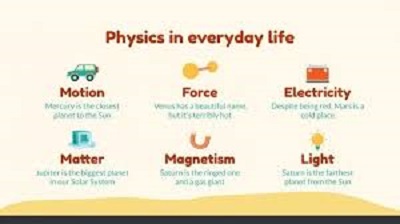1. What is Physics?
Physics is the branch of science concerned with the nature and properties of matter and energy. It deals with concepts such as motion, force, energy, mass, heat, light, sound, electricity, magnetism, and the structure of atoms. Physics explains not only how the universe works but also why it works that way.
For example:
-
Newton’s laws of motion explain how objects move.
-
Einstein’s theory of relativity explains the nature of space and time.
-
Quantum mechanics explains the behavior of particles smaller than atoms.
Thus, physics is not only theoretical but also practical, as it helps us develop technologies that improve human life.
2. Importance of Physics in Human Civilization
Physics has shaped human civilization for centuries. Ancient civilizations used basic principles of physics in building pyramids, constructing tools, and navigating seas. The scientific revolution in the 16th and 17th centuries, led by scientists like Galileo, Kepler, and Newton, changed the world forever. Their discoveries laid the foundation for modern physics and technological progress.
Today, physics remains central to innovations in transportation, communication, medicine, energy, and space exploration. Without physics, our modern world would not exist.
3. Role of Physics in Daily Life
Many people believe that physics is only studied in laboratories or classrooms. In reality, physics is part of everyday life.
-
Electricity and Electronics – From turning on a light switch to charging a phone, all electrical devices work on the principles of physics.
-
Transportation – Cars, trains, airplanes, and ships all move according to Newton’s laws of motion and aerodynamics.
-
Cooking and Heating – The transfer of heat while boiling water or baking food is explained by thermodynamics.
-
Communication – Mobile phones, televisions, and the internet use electromagnetic waves discovered through physics.
-
Sports and Exercise – Every throw, jump, or kick in sports follows the principles of motion, force, and energy.
-
Medicine and Health – X-rays, MRI scans, ultrasound, and laser surgery are all applications of physics in medical science.
-
Nature and Environment – Rainbows, tides, lightning, and earthquakes are explained using physics.
Thus, physics is not distant from life; it is present in everything we do.
4. Branches of Physics
Physics is a vast field, and it is divided into several branches:
-
Classical Mechanics – Deals with the motion of objects.
-
Electromagnetism – Studies electricity, magnetism, and light.
-
Thermodynamics – Explains heat and energy transfer.
-
Quantum Physics – Studies the behavior of very small particles like electrons and photons.
-
Relativity – Introduced by Einstein, it explains time, space, and gravity.
-
Nuclear Physics – Studies the structure of atoms and nuclear reactions.
-
Astrophysics – Explains stars, planets, galaxies, and the universe.
Each branch of physics contributes to new discoveries and inventions.
5. Contribution of Physics to Technology
Most modern technologies are based on physics.
-
Computers and Smartphones – These depend on semiconductors, which are explained by quantum physics.
-
Satellites and GPS – Space physics and mechanics make global navigation possible.
-
Renewable Energy – Solar panels, wind turbines, and hydropower plants are based on the laws of energy and motion.
-
Nuclear Power – Controlled nuclear reactions provide electricity to millions of homes.
-
Medical Devices – Physics has given us life-saving technologies like pacemakers, MRI machines, and radiotherapy.
Thus, physics is the backbone of modern technology.
6. Physics in Education and Career
Studying physics develops logical thinking, problem-solving skills, and creativity. Physics graduates can pursue careers in engineering, computer science, research, space science, teaching, and medicine. Nobel Prize-winning physicists like Albert Einstein, Marie Curie, and Richard Feynman have inspired generations to explore the mysteries of nature.
Physics education not only provides knowledge but also develops curiosity about the world. Students learn to ask questions, design experiments, and find solutions—skills that are valuable in every profession.
7. Challenges and Future of Physics
Even though physics has answered many questions, there are still mysteries left to solve. Scientists are still trying to understand dark matter, black holes, and the origin of the universe. The future of physics lies in exploring these unanswered questions.
With advancements in artificial intelligence, nanotechnology, and space research, physics will continue to push the boundaries of human knowledge. It will play an important role in solving global challenges such as climate change, renewable energy, and medical innovation.


You must be logged in to post a comment.